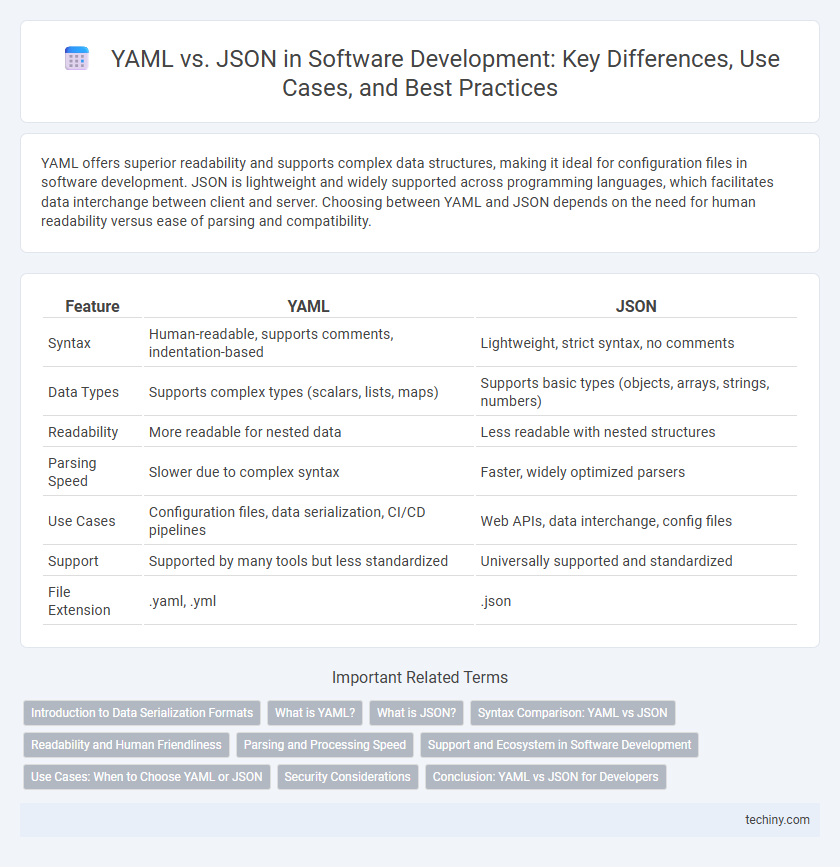YAML offers superior readability and supports complex data structures, making it ideal for configuration files in software development. JSON is lightweight and widely supported across programming languages, which facilitates data interchange between client and server. Choosing between YAML and JSON depends on the need for human readability versus ease of parsing and compatibility.
Table of Comparison
| Feature | YAML | JSON |
|---|---|---|
| Syntax | Human-readable, supports comments, indentation-based | Lightweight, strict syntax, no comments |
| Data Types | Supports complex types (scalars, lists, maps) | Supports basic types (objects, arrays, strings, numbers) |
| Readability | More readable for nested data | Less readable with nested structures |
| Parsing Speed | Slower due to complex syntax | Faster, widely optimized parsers |
| Use Cases | Configuration files, data serialization, CI/CD pipelines | Web APIs, data interchange, config files |
| Support | Supported by many tools but less standardized | Universally supported and standardized |
| File Extension | .yaml, .yml | .json |
Introduction to Data Serialization Formats
Data serialization formats like YAML and JSON enable efficient storage and transmission of structured data in software development. JSON (JavaScript Object Notation) is widely used for its simplicity, lightweight syntax, and compatibility with web APIs. YAML (YAML Ain't Markup Language) offers more human-readable features with support for comments and complex data structures, making it ideal for configuration files and scenarios requiring clarity and flexibility.
What is YAML?
YAML (YAML Ain't Markup Language) is a human-readable data serialization format widely used in software development for configuration files and data exchange. It supports complex data structures such as mappings, sequences, and scalars with indentation-based syntax, making it more readable than JSON for nested data. YAML excels in scenarios requiring comments and multiple document support, enhancing maintainability and clarity in configuration management.
What is JSON?
JSON (JavaScript Object Notation) is a lightweight data interchange format widely used in software development for transmitting data between a server and web applications. It represents data as key-value pairs and arrays, making it easy to read and write for both humans and machines. JSON's simplicity and compatibility with most programming languages contribute to its popularity in APIs, configuration files, and data storage.
Syntax Comparison: YAML vs JSON
YAML syntax is designed to be human-readable with indentation-based structure, avoids quotation marks for strings unless necessary, and supports comments using the "#" symbol, whereas JSON syntax relies heavily on braces, brackets, and uses double quotes for all strings without native comment support. YAML allows more complex data representations, such as multiple documents within a single file and anchors for data reuse, while JSON strictly follows a lightweight data interchange format optimized for machine parsing. The flexibility of YAML's syntax makes it preferable for configuration files, while JSON's strict and concise syntax benefits data interchange in APIs and web services.
Readability and Human Friendliness
YAML offers superior readability with its clear indentation and minimal use of punctuation, making it more human-friendly for configuration files and data representation. JSON, while widely supported and easy for machines to parse, can become cluttered and harder to read with nested structures due to its reliance on braces and brackets. For developers prioritizing clarity and simplicity in manual editing, YAML is often the preferred choice in software development workflows.
Parsing and Processing Speed
JSON parsing typically outperforms YAML due to its simpler, more compact syntax and widespread native support in many programming languages, enabling faster serialization and deserialization. YAML, while more human-readable and flexible with features like comments and complex data structures, often requires more computational resources and time to parse because of its indentation-sensitive format and richer syntax. For performance-critical applications, JSON parsing offers a more efficient solution with lower latency and higher throughput compared to YAML.
Support and Ecosystem in Software Development
YAML and JSON both offer extensive support in software development, with JSON being natively supported in most programming languages and widely used in web APIs, making it highly interoperable. YAML boasts a rich ecosystem of parsers and tools favored in configuration management, especially in DevOps and CI/CD pipelines due to its human-readable format. While JSON's strict syntax facilitates easier integration in development environments, YAML's expressive capabilities and widespread tooling complement complex configuration tasks, solidifying their combined significance in modern software ecosystems.
Use Cases: When to Choose YAML or JSON
YAML is ideal for configuration files and scenarios requiring human readability and complex data structures like nested objects, making it popular in DevOps and infrastructure as code (IaC) tools such as Kubernetes and Ansible. JSON excels in web APIs and data interchange between client-server applications due to its lightweight syntax and native support in JavaScript and most programming languages. When simplicity and fast parsing are priorities, especially in real-time applications, JSON is preferred, whereas YAML suits environments demanding clarity and maintainability in configuration management.
Security Considerations
YAML and JSON both play crucial roles in software configuration, but YAML's support for complex data types and custom tags introduces a higher risk of code injection attacks if not properly sanitized. JSON's simpler structure and strict syntax reduce the attack surface, making it a safer choice for data interchange in security-sensitive applications. Developers must implement rigorous input validation and avoid deserializing untrusted YAML content to prevent exploitation in software systems.
Conclusion: YAML vs JSON for Developers
YAML offers superior readability and support for complex data structures, making it ideal for configuration files and scenarios where human-friendly syntax is crucial. JSON excels in data interchange due to its lightweight format, native compatibility with JavaScript, and widespread support across APIs and web services. Developers should choose YAML for ease of manual editing and JSON for performance and integration in web applications.
YAML vs JSON Infographic

 techiny.com
techiny.com